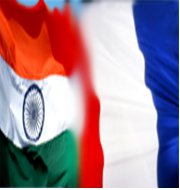India, France Working on Third Joint Space Mission
India and France are working on the “Third Joint Satellite Mission” at the time when the bilateral space collaboration between both the country is entering into multiple domains even in the human spaceflight programme.
Highlights
Several French companies are interested to tap into the opportunities provided by the recent reforms in the space sector by the government. France is also the largest partner of India in Space. ISRO highlighted that, ISRO and French space agency Centre National d’Études Spatiales (CNES) have worked on the two joint missions namely the ‘Megha-Tropiques’ which was launched in the year 2011 and the ‘SARAL-Altika’ which was launched in the year 2013.
ISRO-CNES
The officials also highlighted that, the ISRO and CNES have completed the feasibility study in order to realise earth observation satellite mission with the help of thermal infrared imager called “Thermal infraRed Imaging Satellite for High resolution Natural resource Assessment (TRISHNA)”. Now both the agencies are working to finalise an implementing arrangement for the joint development. India is also working with the France on joint experiments & accommodation of the scientific instruments with respect to the space missions. Two agencies have also finalised all the interface control documents to accommodate the ‘ARGOS’ instrument of CNES in the OCEANSAT-3 satellite of ISRO.
About ARGOS
ARGOS is a satellite-based system which is involved in the collecting, processing and disseminating the environmental data from a fixed and a mobile platform worldwide. It also helps in the data collection by the satellite. This makes the Argos more useful in geographically locating the data source from any location on the Earth using the Doppler effect. It was established in the year 1978. The ARGOS have provided the data for the environmental research and protection of communities.
OCEANSAT-3
The ISRO spacecraft Oceansat-3 is being developed in order to provide the service continuity for the operational users of Ocean Colour Monitor data from Oceansat 2. It also seeks to enhance the application potential in other areas. It is a global mission which has been configured to cover the global oceans and to provide a continuity of ocean colour data. The mission seeks to provide the continuity of ocean colour data along with the improvements to enhance the operational services such as potential fishery zone and the primary productivity.
Month: Current Affairs - March, 2021







